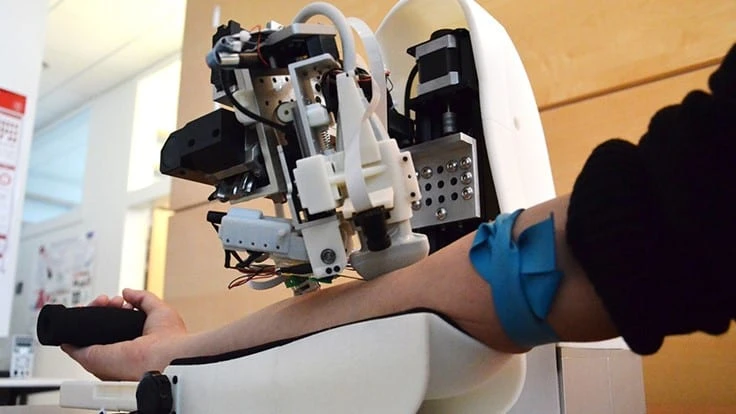
Martin Yarmush and Alvin Chen
Rutgers University engineers have created a tabletop device that combines a robot, artificial intelligence (AI), and near-infrared and ultrasound imaging to draw blood or insert catheters for fluid and drug delivery.
Research results, published in the journal Nature Machine Intelligence, suggest medical robots could reduce injuries, improve procedure efficiency and outcomes, and carry out tasks with minimal supervision when resources are limited.
“Using volunteers, models, and animals, our team showed that the device can accurately pinpoint blood vessels, improving success rates and procedure times compared with expert health care professionals, especially with difficult to access blood vessels,” says senior author Martin L. Yarmush, Paul & Mary Monroe Chair & Distinguished Professor in the Department of Biomedical Engineering in the School of Engineering at Rutgers University–New Brunswick.
Access to veins, arteries, and other blood vessels is a critical first step in many diagnostic and therapeutic procedures such as drawing blood, administering fluids and medications, introducing devices such as stents, and monitoring health, but gaining access to blood vessels in many people can be quite challenging.
Failures occur in an estimated 20% of procedures, and difficulties increase in people with small, twisted, rolling, or collapsed blood vessels, which are common in pediatric, elderly, chronically ill, and trauma patients, the study says. In these groups, the first-stick accuracy rate is below 50% and at least five attempts are often needed, leading to delays in treatment. Bleeding complications can arise when major adjacent arteries, nerves, or internal organs are punctured, and the risk of complication rises significantly with multiple attempts. When nearby blood vessels are inaccessible, more invasive approaches such as central venous or arterial access are often required.
The robotic device can accurately steer needles and catheters into tiny blood vessels with minimal supervision. It combines artificial intelligence (AI) with near-infrared and ultrasound imaging to perform complex visual tasks, including identifying the blood vessels from the surrounding tissue, classifying them, estimating their depth, and is followed by motion tracking.
Next steps include more research on the device in a broader range of people, including those with normal and difficult blood vessels to access.
The lead author is Alvin Chen, who earned a doctorate at Rutgers. Co-authors include Max L. Balter and Timothy J. Maguire, who also earned doctorates at Rutgers, all under the supervision of Yarmush.
Latest from Today's Medical Developments
- The toolbelt generation
- Covestro's role in transforming cardiac care
- Practical and Affordable Factory Digital Twins for SMEs
- UCIMU: fourth quarter 2024 machine tool orders on the rise
- Thomson Industries’ enhanced configuration capabilities
- Frequently Asked Questions about AM Post Processing
- How new executive orders may affect US FDA medical device operations
- Midwest DISCOVER MORE WITH MAZAK





